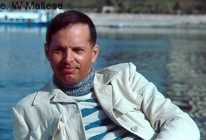
 Writer
William Maltese interviews artist/writer Rick Chris
Writer
William Maltese interviews artist/writer Rick ChrisVisit both writers' websites
William Maltese
Rick Chris
[William Maltese is an internationally published best-selling author, with over one-hundred books to his credit; Rick Chris is an artist/author whose realistic paintings of the male nude form have gained him international attention, his on-line serialization of his Beef Matson mystery the subject of the review found on page 17 in this issue].
WILLIAM MALTESE (WM): Rick, why the Beef Matson book when you’re obviously so good at painting?
RICK CHRIS (RC): The complete story came to me during a stay in the hospital. I thought as long as I had the plot line, I might as well do something with it, even though I don't consider myself a writer. I figured that people would probably send me e-mails slamming the story and telling me to go back to being an artist, but that didn't happen; instead, it turned out that people actually seemed to like the serial.
WM: Does writing fulfill some kind of need for you that painting doesn’t?
RC: I’ve found that writing is much like painting, in that you’re creating scenes and portraits of people, only using words instead of paint. Also, I found that I write much like I paint. I start out with a basic idea and add detail from everyday life so that the images are something with which viewers can easily identify. With this story, I just added additional details, dialogue and subplots to make the universe of Beef Matson more lived in and, therefore, more real.
WM: Why a detective novel?
RC: I've always loved detective and mystery novels, TV-show and old-time radio detectives; American TV used to have lots. The detective/mystery shows produced in the U.K., today, are really very good, too. I love a mystery story that's a good puzzle — anything from an adaptation of some Agatha Christie work to Rosemary and Thyme. I'll admit that A PERSON IN A POSITION OF TRUST is more fantasy than detective novel, but it holds all the classic private-dick story elements: detective hero, assistant, office in an old building, villains, and plot twists, etc.
WM: Why “Beef Matson”?
RC: Originally, he was just a name I came up with for the cover graphic of an imaginary detective novel I did for a series of paintings satirizing the book covers, TV and movie posters, of the 1940’s and 50’s. Suddenly, he just seemed to have been waiting around patiently for me to do something more with him.
WM: Your writing seems so familiar with homophobic right-wing whacko groups, are you writing from personal experiences?
RC: Oh good golly gosh, yes. First off, much of the filler detail in the story, like the woman who almost gets strangled by a feather boa, comes from actual events I've witnessed. And I've worked at some very conservative companies, coming into contact with some individuals who are way — and I do mean way —out there, if you want to talk right-wing whacko. The characters Gloria and Bessie are drawn from two people I worked with at a company, some years ago. The owner of the company was an extremely rich individual with very close ties to some well known right-wing Republicans; he wanted his employees to be more right-wing religious but didn't want to be obvious; so, he quietly forced “undesirable” employees out by making their working environment hell. I wasn’t completely aware of what was going on because, at the time, no one would say anything. It wasn't until years later, after I left the company and ran into others who had worked there, that I got the more complete picture. Anyway, the real Gloria was this very religious but very conniving woman who helped the company get rid of people in the most nasty ways possible. The real Bessie was a lesbian who regularly reported to the company about who was gay so the company could then apply the pressure to get rid of them. Supposedly, Bessie got another lesbian fired by finding out this other woman regularly exchanged e-mails with a gay rights organization on company time. The company gave Bessie a promotion. I couldn’t figure out from where she was coming until I chatted a few years later with those gay women who knew her better than I did. Apparently, Bessie had this extreme co-dependent attraction to older, right-wing authoritarian type women. The gay women who told me thought her fetish was cute; I thought it was pathetic. I guess my having come in contact with the likes of Bessie helps me better understand people like Mary Cheney.
WM: Why a serialization, on-line, and not just a submission of the finished manuscript to a book publisher?
RC: It was just a matter of my not seeing me as a writer. I thought people would be very critical of my attempt at writing. So, I never even came close to considering submitting the manuscript to a publisher, thinking that doing so would be pointless.
WM: Do you know, at this point, where your characters will end up and how the book will end?
RC: While, as mentioned, I started out with the entire plot of the story in mind, my originally intended ending will, in fact, be slightly different for the character Randy who deserves better because of all he goes through. When I put the final chapter on-line, I may provide the original ending, too, allowing readers a comparison.
WM: Will you eventually, do you think, submit to a hard-copy publisher?
RC: That’s a possibility. Putting A.P.I.A.P.O.T. on my site has given me a preview of people's reactions. Also, I printed out a hard copy that got passed around, resulting in some very positive feed-back. The bottom line with hard-copy publishing is whether or not a book is marketable, and I think the Beef Matson story has already proven that it is. I'd like to tweak the first chapters, though, because I put those together when I was having intermittent asthma attacks; I'd, also, probably add more illustrations for any hard-copy version. Plus, I’d like to have some reader reactions to my last chapter which might be regarded, by some, as controversial.
WM: A lot of full-time authors seem to see little advantage in publishing anything on-line. What kind of feedback, positive and/or negative, have you received from people who checked in to see your artwork but end up reading your serialized novel?
RC: My idea for publishing on line was just my attempt to add interest and value to my web site – a serialized mystery novel, maybe, one more reason for visitors to visit. Since I didn’t initially consider myself a writer, the pros and cons of publishing online were never issues with me. Gradually, I found the story seemed to have a loyal following; I’d even hear complaints when I was sluggish in getting the next chapters online. I do have people reading on a whim, once they discover my site, because they’re unaware there’s even such a “thing” as gay mystery genre and/or are unaware of venues in which they can purchase it. My Beef Matson story, available through the convenience of the web, has definitely helped some people discover the genre. Also, e-mails invariably ask when I plan to come out with “an actual book.” It seems many people don't like reading online and prefer hard-copies — after all, it’s easier to curl up with a book than it is to curl up with a computer; plus, books are easier to carry to the lunchroom, or to the corner coffeehouse, and are much gentler on the eyes.
WM: You’ve provided several of your paintings as visual supplemental to your novel. Did you always intend to illustrate parts of your story, or was that something that you decided after you started writing?
RC: Being an artist, it seemed natural to provide illustrations. For a good part of my working life, I did illustrations for technical publications; although, those weren’t very exciting. Also, I remember books that were once serialized and illustrated in newspapers and magazines. I believe the Sherlock Holmes stories were originally published that way for English commuters to enjoy on the train. My feeling being that a good illustration adds to any story. Actually, I’ve toyed with doing comic-strip panels of small parts of the story and publishing them, along with the text. It would just be a case of finding the time to do so. And, if and when the Beef Matson story is published as a “real” book, I’d probably want to add a lot more illustrations (as suggested by my readers). In this multi-media world, adding depth to a story via original illustrations is probably a good idea as far as marketing goes.
WM: And, finally, do you see A.P.I.A.P.O.T. as just the first book of an eventual Beef Matson series?
RC: I've received comments from readers that they’d like to see a series. I might have a problem, though, since I still don't completely identify as a writer. One guy e-mailed that he would like to see Beef as a gay James Bond type. Whatever — if I were to do a series, Beef would play a much bigger role than in this lead book wherein plot revolves mainly around his assistant Randy. I do have another rough idea; the detective investigates the disappearance of a couple of male erotic dancers, the trail leading him to a semi-deserted Nevada ghost town and a cache of WWII treasure. That one, I think, would be more a more traditional detective story than this one.
END